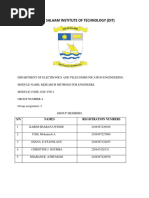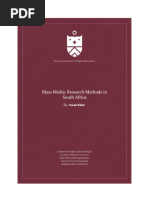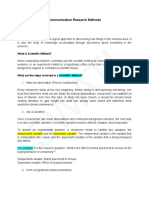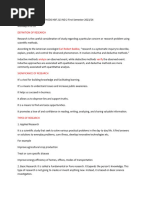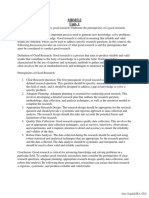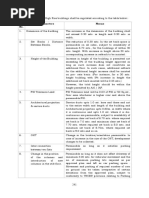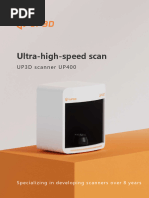Research Process MGMT 201 Psda
Research Process MGMT 201 Psda
Uploaded by
Chirag RastogiCopyright:
Available Formats
Research Process MGMT 201 Psda
Research Process MGMT 201 Psda
Uploaded by
Chirag RastogiCopyright
Available Formats
Share this document
Did you find this document useful?
Is this content inappropriate?
Copyright:
Available Formats
Research Process MGMT 201 Psda
Research Process MGMT 201 Psda
Uploaded by
Chirag RastogiCopyright:
Available Formats
Research Methodology and
Report Preparation
(MGMT-201)
TOPIC:
Steps in Research Process
Submitted To: Dr. Isha Gupta
Submitted By: Mr. Chirag Rastogi
Enrollment No: A3221620022
Course: B.Com. LL.B. (H)
Research Process
The research process consists of a series of systematic procedures that a researcher must go
through in order to generate knowledge that will be considered valuable by the project and
focus on the relevant topic.
In other words, the research process is similar to undertaking a journey. For a research
journey there are two important decisions to make:
1) What you want to find out about or what research questions (problems) you want to
find answers to;
2) How to go about finding their answers.
There are practical steps through which you must pass in your research journey in order to
find answers to your research questions. The path to finding answers to your research
questions constitutes research methodology.
At each operational step in the research process you are required to choose from a
multiplicity of methods, procedures and models of research methodology which will help
you to best achieve your objectives. This is where your knowledge base of research
methodology plays a crucial role.
To conduct effective research, you must understand the research process steps and follow
them. Here are a few steps in the research process:
Step 1: Identify the Problem
Finding an issue or formulating a research question is the first step. A well-defined problem
will guide the researcher through all stages of the research process, from setting objectives
to choosing a technique. There are a number of approaches to get insight into a topic and
gain a better understanding of it. Such as:
A preliminary survey
Case studies
Interviews with a small group of people
Observational survey
To define a problem correctly, a researcher must know what a problem is? What is a
Research problem a problem can be called a research problem if it satisfies the following
condition;
It must be worth studying
The study of the problem must be socially useful
A research problem should come out with solutions to the issue.
Step 2: Evaluate the Literature
A thorough examination of the relevant studies is essential to the research process. It
enables the researcher to identify the precise aspects of the problem. Once a problem has
been found, the investigator or researcher needs to find out more about it.
This stage gives problem-zone background. It teaches the investigator about previous
research, how they were conducted, and its conclusions. The researcher can build
consistency between his work and others through a literature review. Such a review exposes
the researcher to a more significant body of knowledge and helps him follow the research
process efficiently.
Step 3: Create Hypotheses
Formulating an original hypothesis is the next logical step after narrowing down the
research topic and defining it. A belief solves logical relationships between variables. In
order to establish a hypothesis, a researcher must have a certain amount of expertise in the
field.
It is important for researchers to keep in mind while formulating a hypothesis that it must
be based on the research topic. Researchers are able to concentrate their efforts and stay
committed to their objectives when they develop theories to guide their work.
A research hypothesis is a predictive statement capable of being tested by scientific
methods.
It should be clear and precise
It should be capable of being tested
Step 4: The Research Design
Research design is the plan for achieving objectives and answering research questions. It
outlines how to get the relevant information. Its goal is to design research to test
hypotheses, address the research questions, and provide decision-making insights.
The research design aims to minimize the time, money, and effort required to acquire
meaningful evidence. This plan fits into four categories:
Exploration and Surveys
Experiment
Data Analysis
Observation
Step 5: Describe Population
Research projects usually look at a specific group of people, facilities, or how technology is
used in the business. In research, the term population refers to this study group. The
research topic and purpose help determine the study group.
Suppose a researcher wishes to investigate a certain group of people in the community. In
that case, the research could target a specific age group, males or females, a geographic
location, or an ethnic group. A final step in a study’s design is to specify its sample or
population so that the results may be generalized.
Step 6: Data Collection
Data collection is important in obtaining the knowledge or information required to answer
the research issue. Every research collected data, either from the literature or the people
being studied. Data must be collected from the two categories of researchers. These sources
may provide primary data.
Experiment
Questionnaire
Observation
Interview
Secondary data categories are:
Literature survey
Official, unofficial reports
An approach based on library resources
Step 7: Data Analysis
During research design, the researcher plans data analysis. After collecting data, the
researcher analyzes it. The data is examined based on the approach in this step. The
research findings are reviewed and reported.
Data analysis involves a number of closely related stages, such as setting up categories,
applying these categories to raw data through coding and tabulation, and then drawing
statistical conclusions. The researcher can examine the acquired data using a variety of
statistical methods.
Step 8: The Report-writing
After completing these steps, the researcher must prepare a report detailing his findings.
The report must be carefully composed with the following in mind:
The Layout: On the first page, the title, date, acknowledgments, and preface should
be on the report. A table of contents should be followed by a list of tables, graphs,
and charts if any.
Introduction: It should state the research’s purpose and methods. This section
should include the study’s scope and limits.
Summary of Findings: A non-technical summary of findings and recommendations
will follow the introduction. The findings should be summarized if they’re lengthy.
Principal Report: The main body of the report should make sense and be broken up
into sections that are easy to understand.
Conclusion: The researcher should restate his findings at the end of the main text.
It’s the final result.
Conclusion
The research process involves several steps that make it easy to complete the research
successfully. The steps in the research process described above depend on each other, and
the order must be kept.
You might also like
- Methods of Research: Simple, Short, And Straightforward Way Of Learning Methods Of ResearchFrom EverandMethods of Research: Simple, Short, And Straightforward Way Of Learning Methods Of ResearchRating: 4.5 out of 5 stars4.5/5 (6)
- Finished Wood Cleaner (Formulation #US FC 34)Document1 pageFinished Wood Cleaner (Formulation #US FC 34)nano100% (2)
- RHS Practical House Plant Book - Choose The Best, Display Creatively, Nurture and Care, 175 Plant Profiles (PDFDrive)Document226 pagesRHS Practical House Plant Book - Choose The Best, Display Creatively, Nurture and Care, 175 Plant Profiles (PDFDrive)carolina vazquez100% (9)
- Market ResearchDocument5 pagesMarket ResearchlevonmwahaveNo ratings yet
- Stages of Research ProcessDocument7 pagesStages of Research ProcessAbnet KifleNo ratings yet
- Week-3-Research-Process-09032024-102337pm 6Document4 pagesWeek-3-Research-Process-09032024-102337pm 6mariumzahid987No ratings yet
- Aritra Karforma (CA2) - MB 105Document6 pagesAritra Karforma (CA2) - MB 105murmusupriya1818No ratings yet
- Research Process StepsDocument11 pagesResearch Process StepsAryan VermaNo ratings yet
- Q - 1 Describe Steps in Research Process: Step 1: Identify The ProblemDocument4 pagesQ - 1 Describe Steps in Research Process: Step 1: Identify The ProblemAbu MusaNo ratings yet
- Untitled DocumentDocument4 pagesUntitled Document070Mishkat HossainNo ratings yet
- Methods of Research PPT 1 1Document113 pagesMethods of Research PPT 1 1Cheyenne NableaNo ratings yet
- Unit 1 Assignment in ResearchDocument3 pagesUnit 1 Assignment in ResearchJovzNo ratings yet
- Research MethodologyDocument21 pagesResearch MethodologynithashaindrojuNo ratings yet
- Media Research Reference 1 to 4 UnitDocument27 pagesMedia Research Reference 1 to 4 UnitadiknightontopNo ratings yet
- Major Steps in Research ProcessDocument21 pagesMajor Steps in Research Processalshamyb309No ratings yet
- An Introduction To Research and An Overview of The Reserch ProcessDocument15 pagesAn Introduction To Research and An Overview of The Reserch ProcessLiezel NoahNo ratings yet
- Chapter Two-1Document33 pagesChapter Two-1Mardeya Jahan TonnyNo ratings yet
- Research Methods - QM - ModelingSimulationDocument61 pagesResearch Methods - QM - ModelingSimulationMarvinNo ratings yet
- Research MethodologyDocument4 pagesResearch MethodologyBinge CreationNo ratings yet
- RRRRDocument72 pagesRRRRVenkateswara Raju100% (1)
- Research ProcessDocument3 pagesResearch ProcessKevin Francis Echon MagaoayNo ratings yet
- 202Document15 pages202monthlyreportcharhiNo ratings yet
- Masters Research MethodologyDocument35 pagesMasters Research MethodologyNgwisah AkamangwaNo ratings yet
- Lecture 03Document24 pagesLecture 03Ziaullah KhanNo ratings yet
- Lecture 2Document39 pagesLecture 2Marisha McAuliffeNo ratings yet
- RM (Full Notes)Document74 pagesRM (Full Notes)Raveendhar.S -MCA100% (1)
- Instruction For G3Document3 pagesInstruction For G3Nguyễn Ngọc VyNo ratings yet
- Investigatory Project 2Document4 pagesInvestigatory Project 2ronald caballesNo ratings yet
- Introducing ResearchDocument13 pagesIntroducing Researchdeo cabradillaNo ratings yet
- Dar Es Salaam Institute of Technology (Dit) : S/N Names Registration NumbersDocument5 pagesDar Es Salaam Institute of Technology (Dit) : S/N Names Registration NumbersMohamedi Ally UssiNo ratings yet
- Research MethodologyDocument73 pagesResearch MethodologyDawaNo ratings yet
- Aruma 294Document6 pagesAruma 294harisonkamau254No ratings yet
- Steps in ReasearchDocument18 pagesSteps in ReasearchtotacomNo ratings yet
- RM Unit-2Document23 pagesRM Unit-2surbhi jhaNo ratings yet
- Introduction to Research Assignment (1)Document20 pagesIntroduction to Research Assignment (1)uwaislegrange24No ratings yet
- BRM Unit - 1 Introduction To ResearchDocument85 pagesBRM Unit - 1 Introduction To ResearchPreetham MNo ratings yet
- Research Process 8 StepDocument8 pagesResearch Process 8 Stepizazalicutie07No ratings yet
- Communication Research MethodsDocument7 pagesCommunication Research MethodsswatiNo ratings yet
- Research Met MB 0050Document8 pagesResearch Met MB 0050Meenakshi HandaNo ratings yet
- RMS Assignment-2 Jahanzeb 30469Document6 pagesRMS Assignment-2 Jahanzeb 30469Jahan Zeb KhanNo ratings yet
- What Are The Stages in The Research Process?Document3 pagesWhat Are The Stages in The Research Process?Jovz100% (1)
- Research Methodology Past Papers Solved Short QuestionsDocument43 pagesResearch Methodology Past Papers Solved Short QuestionsneelakbatooolNo ratings yet
- Research For Dissertation A Updated Nov2019Document16 pagesResearch For Dissertation A Updated Nov2019nouserheadNo ratings yet
- Brm_unit- 1 Introduction to ResearchDocument85 pagesBrm_unit- 1 Introduction to ResearchPrathap PrathuNo ratings yet
- Techno Professional SkillDocument8 pagesTechno Professional Skillasif ahmedNo ratings yet
- Research Methods NotesDocument85 pagesResearch Methods NotesMumbere MuuminuNo ratings yet
- Meaning of ResearchDocument11 pagesMeaning of ResearchRahulNo ratings yet
- (Repaired)Document33 pages(Repaired)techalukindie tadesseNo ratings yet
- Lecture 2_ Research ProblemDocument26 pagesLecture 2_ Research Problembadeerubaid2015No ratings yet
- Research ProcessDocument16 pagesResearch Processjeffsatur9104No ratings yet
- Business Research Methods-Wps Office-1Document9 pagesBusiness Research Methods-Wps Office-1Paulahonye764No ratings yet
- Business Research Definition of Research Is Given by Martyn ShuttleworthDocument4 pagesBusiness Research Definition of Research Is Given by Martyn ShuttleworthAamirNo ratings yet
- Research MethodologyDocument24 pagesResearch MethodologySANKARA RAO NEIGAPULANo ratings yet
- Unit 1 ResearchDocument5 pagesUnit 1 ResearchSarvesh ShahNo ratings yet
- What Is Research?Document47 pagesWhat Is Research?Kavya KavsNo ratings yet
- Research Process - PR RESEARCHDocument4 pagesResearch Process - PR RESEARCHPratik SahaNo ratings yet
- MBM512 QB Solved PDFDocument28 pagesMBM512 QB Solved PDFMayank bhardwajNo ratings yet
- Steps of Research - 01 - NotesDocument9 pagesSteps of Research - 01 - NotesKrishna NimmakuriNo ratings yet
- Participatory Action Research for Evidence-driven Community DevelopmentFrom EverandParticipatory Action Research for Evidence-driven Community DevelopmentNo ratings yet
- Research Proposal a Simplified Step-by-Step Guide - Revised EditionFrom EverandResearch Proposal a Simplified Step-by-Step Guide - Revised EditionNo ratings yet
- Corporate tax Module 1Document40 pagesCorporate tax Module 1Chirag RastogiNo ratings yet
- It Is The Utmost Obligation of State Authorities, Including Police, To Respect and Protect The Right To LifeDocument2 pagesIt Is The Utmost Obligation of State Authorities, Including Police, To Respect and Protect The Right To LifeChirag RastogiNo ratings yet
- SSMP Industries LTD VS Perkan Food Processors PVT LTDDocument4 pagesSSMP Industries LTD VS Perkan Food Processors PVT LTDChirag RastogiNo ratings yet
- Microsoft Word - TNCD&BR 2019 - Book - 02.02.2019Document2 pagesMicrosoft Word - TNCD&BR 2019 - Book - 02.02.2019Chirag RastogiNo ratings yet
- Integrasi Asesmen Dan Pembelajaran: Bahrul HayatDocument28 pagesIntegrasi Asesmen Dan Pembelajaran: Bahrul HayatCici RahmatillahNo ratings yet
- Hansikaparna NeogDocument1 pageHansikaparna NeogARIHANT SERVICESNo ratings yet
- Up3D - UP400Document6 pagesUp3D - UP400ArizalNo ratings yet
- Tourism Marketing Case Studies - Alexandru Nedelea and Babu GeorgeDocument261 pagesTourism Marketing Case Studies - Alexandru Nedelea and Babu GeorgeBabu George50% (2)
- NLMK in Hot Rolled ProductsDocument7 pagesNLMK in Hot Rolled Productsafraz_xecNo ratings yet
- Boris Groys The Museum As A Cradle of RevolutionDocument8 pagesBoris Groys The Museum As A Cradle of RevolutionCristine CarvalhoNo ratings yet
- Spelling Bee Competition Grade 8: E. Rodriguez Jr. High SchoolDocument65 pagesSpelling Bee Competition Grade 8: E. Rodriguez Jr. High SchoolJinky GampongNo ratings yet
- WLC - Show Run ConfigDocument611 pagesWLC - Show Run ConfigMohammad AldehneeNo ratings yet
- USD School of Law, Chaker V Crogan DiscussionDocument68 pagesUSD School of Law, Chaker V Crogan DiscussionDarren Chaker100% (1)
- Affidavit of LossDocument1 pageAffidavit of LossAmanda HernandezNo ratings yet
- Am 120 Mkiii AM 220 AM 220P: English Deutsch Español Français Português 日本語 简体中文Document36 pagesAm 120 Mkiii AM 220 AM 220P: English Deutsch Español Français Português 日本語 简体中文OscarNo ratings yet
- Jamia Millia Islamia: Project of SociologyDocument8 pagesJamia Millia Islamia: Project of SociologyAltamash SiddiquiNo ratings yet
- Dats Explained PDFDocument2 pagesDats Explained PDFShubham OjhaNo ratings yet
- Topic 4 Curriculum and The TeacherDocument16 pagesTopic 4 Curriculum and The TeacheryunabahNo ratings yet
- A Qualitative Systematic ReviewDocument18 pagesA Qualitative Systematic ReviewJose ShelldonNo ratings yet
- Final ResumeDocument2 pagesFinal Resumekazuya hentsNo ratings yet
- Panelview Plus 7 Standard Terminals: User ManualDocument156 pagesPanelview Plus 7 Standard Terminals: User ManualMarcos MouraNo ratings yet
- Teaching Physical EducationDocument34 pagesTeaching Physical EducationHannah Naomi ParongNo ratings yet
- Cot 1-Mathematics 6Document9 pagesCot 1-Mathematics 6Maria cristina franciscoNo ratings yet
- Compressor Settleout Pressure Temperature EstimationDocument3 pagesCompressor Settleout Pressure Temperature EstimationMirsoNo ratings yet
- Pre-Feasibility Study: Gaming ZoneDocument25 pagesPre-Feasibility Study: Gaming ZoneShehraam MalikNo ratings yet
- Paper 2 Reasoning Worked ExamplesDocument21 pagesPaper 2 Reasoning Worked ExamplesKrishnapriya GovindNo ratings yet
- Experiment 1 Aim AssignmentDocument19 pagesExperiment 1 Aim Assignmentridhi guptaNo ratings yet
- Steganography and Cryptography: Presentation OnDocument38 pagesSteganography and Cryptography: Presentation Onajaytaneja100% (1)
- Started On Sunday, April 12, 2020, 3:55 PM: Question TextDocument8 pagesStarted On Sunday, April 12, 2020, 3:55 PM: Question Textyuliana diazNo ratings yet
- Manual MSA Lineas de VidaDocument92 pagesManual MSA Lineas de VidaHllcNo ratings yet
- 8 Dimensions of QualityDocument3 pages8 Dimensions of QualitySindhuja RavikumarNo ratings yet
- Temples in MyanmarDocument1 pageTemples in Myanmarpromodai122No ratings yet






























